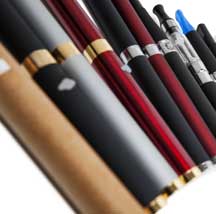 With Big Tobacco now in the game, electronic tobacco products are poised to take an enormous leap forward.
With Big Tobacco now in the game, electronic tobacco products are poised to take an enormous leap forward.
By Howard Riell, Associate Editor.
While some view electronic cigarettes as a threat to the cigarette industry, others see them as a lifeboat of sorts, providing smokers who don’t want to or can’t smoke cigarettes anymore—for a host of reasons—with a viable alternative.
While cigarettes sales have been trending downward for years, a combination of recent factors, including a tepid economy, stubborn unemployment, a rise in payroll taxes and higher prices at the pump, have underscored the drop.
E-cigarette sales numbers are proving impressive. Some analysts have predicted that their usage could surpass that of traditional cigarettes in 10 years, which makes sense considering R.J. Reynolds, Altria, Lorillard and National Tobacco Co. have all elbowed their way into the e-cigarette segment.
Battery powered e-cigarettes, which first hit American store shelves in 2006, look like traditional cigarettes, though some resemble pens. An electrical coil inside warms a replaceable cartridge soaked in nicotine. The coil vaporizes the nicotine, which is then inhaled by the user. Since they are non-flammable, don’t contain tobacco and give off no secondhand smoke, they have been used without fuss in restaurants, workplaces and other places in which traditional tobacco smoking is either discouraged or prohibited.
A 2011 research project by the Centers for Disease Control and Prevention (CDC) estimated that about 21% of adult smokers had used electronic cigarettes, a rise of about 10% over the previous year. In both years, the CDC reported, e-cigarette use was significantly higher among current smokers compared to former and nonsmokers. Overall, the group added, roughly 6% of American adults have sampled e-cigarettes, a number which has surely gone up.
Unlike traditional tobacco products, most e-cigarettes are not regulated by the FDA, which is why the group has complained that it has no way of knowing the levels of nicotine or other chemicals in them. It says it intends “to study” the category going forward.
Electric Heat
In April, Altria Group Inc. said it will join the e-cigarette market later this year. Executives at several tobacco companies have recently said publicly that they believe cigarette revenues are being cannibalized by rising consumer interest in e-cigarettes. Altria reported that a subsidiary designed to develop new products will introduce e-cigarettes in the second half of 2013.
“Awareness and trial of e-cigarettes have increased over the last year, a subject to which we have been devoting attention and product-development resources,” Chairman and Chief Executive Marty Barrington said last month in the company’s announcement of its e-cigarette trial. “There is no denying that adult tobacco consumers have shown some interest in it.”
Competitors Lorillard Inc. and Reynolds American Inc. are already in the e-cigarette race, and the reason is obvious: the category could be worth nearly $1 billion at retail this year, according to Lorillard estimates.
Bonnie Herzog, managing director for beverage, tobacco and consumer research for Wells Fargo Securities in New York City, has spoken widely about the fact that e-cigarettes are becoming even more affordable than their traditional counterparts. That affordability gap should continue to widen, driving up demand for the less expensive product.
“Packaging changes for e-cigs should help drive consumer awareness and trial of the category,” Herzog said. “First, improved packaging including more attractive price points for multi-cartomizer and disposable packs were noted to already be growing in demand. These multi-packs result in a cheaper per-cartomizer or per unit cost and, combined with low/no taxes on e-cigs, they further widen the relative affordability gap of e-cigs versus traditional cigs.”
This should drive accelerated growth for e-cigarettes. Hitting the market this summer will be a five-cartomizer starter kit that is half the price of the current kit, Herzog reported. Another maker is marketing a five-pack disposable kit at a lower price per unit.
“Our industry contacts were cautiously optimistic regarding Altria’s recent announcement to enter the e-cig category with a product of its own during the second half of 2013. Many actually wondered why it took them so long, with several acknowledging it was inevitable they would get in,” Herzog said.
Beyond that, Herzog noted, improved disposable e-cig packaging is expected to drive increased consumer acceptance. “As this affordability gap widens, and consumption of e-cigs increases while consumption of traditional cigs declines, this will clearly result in lower government revenue from cig taxes,” she said.
“Therefore, as governments seek alternative revenue sources to make up for lost revenue from declining cig taxes, we believe this could drive increased regulatory scrutiny on other industries, such as food and beverages.”
C-Store Disadvantage
Robert Perkins, vice president of marketing at York, Pa.-based Rutter’s Farm Stores, said that sales of e-cigarettes have been very positive at his stores, and should remain so. “I think that you had the explorers early, but now it’s becoming a little bit more mainstream.”
To sell more, Perkins suggested, convenience store retailers need to focus on the same basics that work for other categories. “I think you’ve got to display them correctly and let your customers know you’ve got them, and with different options.”
Rutter’s stores place e-cigarettes in two locations: up front by the registers and along the back bar.
At this stage in the product’s life cycle education is key, said Bridget Moore, who owns two All Smoke Free stores, which sell only electronic tobacco products, in Alabama.
Demographically, Moore’s customers cover the gamut, as do the reasons they are seeking out e-cigarettes. “A lot of people who get into this basically want an alternative to smoking a regular cigarette,” she said. “They want something less expensive that does not have all the added chemicals in it. They want something they feel they can smoke around other people without exposing them to that second-hand smoke.”
Moore’s stores offer product demonstrations, informational videos and lots of opportunities for customers to sample before they buy. “We invite them to come in and sit down. Then we will spend about 10 minutes with each customer going over the electronic cigarette basics,” she said. “We also explain things to them in a hands-on way—how to refill it, how to use it, how to charge it and even a little bit of troubleshooting.”
Moore, who was part of a tobacco roundtable at the recent NATO show in Las Vegas, sells both rechargeable and disposable e-cigarettes.
Proper Training Key
Perkins agreed that, as with many other categories, there is an educational process involved in selling e-cigarettes. “I think that is still the struggle that everybody is going to have because there are a lot of new entrants into the category. From a customer’s standpoint it can be confusing,” he said.
It is because of this need for product education, Moore suggested, that convenience stores may well be at a competitive disadvantage in marketing e-cigarettes.
“I think there is a disconnection between the owner of the convenience store and the customer,” Moore said. “Customers run in, pick up their snacks and smokes and they are out of there.” Information, she added, will not be available to them in most cases. “People may ask the kid behind the counter, ‘What can you tell me about this?’ and they say, ‘I don’t know.’ He may not even know how much it is. This is a service we are offering and emphasize.”
All Smoke Free is forming a distribution company, targeting local grocery stores and service stations. “I feel there is a great future for e-cigs and we have only begun to see the possibilities that are ahead for this industry,” Moore said. “I only hope the government chooses a way to regulate them that will allow me to continue selling through my businesses.”




